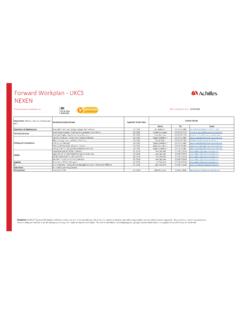Transcription of ASSESS CONTRIBUTIONS Second step of your entitlement ...
1 PROPERTY 7 25. ASSESS CONTRIBUTIONS . Second step of your entitlement calculations Just as the court will undertake if your case does not settle, this is the next stage of calculations once the net asset pool has been identified to apply a percentage of that pool as an assessment of the parties' s 79(4) CONTRIBUTIONS . Types of contribution a) Financial CONTRIBUTIONS by or on behalf of a party to the acquisition, conservation or improvement of any property of the parties or either of them (such as a party's earnings;. or money or other assets brought into the marriage by a party or their parents; or a party's payment of deposit, loan repayments or other outgoings, or expenses to acquire, maintain or improve real estate, business, cars or other property). b) Non-financial CONTRIBUTIONS to the acquisition, conservation or improvement of such property by or on behalf of a party (work done towards the maintenance or improvement of property, including a business; or a wife's unaided child and home duties enabling the husband to pursue his business activities).
2 C) CONTRIBUTIONS to the welfare of the family (the other party and any children) including any contribution as homemaker or parent Included in the above are CONTRIBUTIONS . being an asset brought into the marriage by a party, the value of which as at time of hearing (despite resulting from market forces), not its value when first contributed: Williams [2007] FamCA 313 (FC). made to property during pre-marital cohabitation: Collins (1977) FLC 90-286 (FC). as homemaker and parent during pre-marital cohabitation: Olliver (1978) FLC 90-499 (FC). relating to previously owned property ( whether or not it has ceased to be their property . as defined in s 79(4)(a)). made to property after separation: Jacobson (1989) FLC 92-003 (FC). as a parent after separation: Pierce (1999) FLC 92-844 (FC); [1998] FamCA 74. to a future expectant interest in property: James (1978) FLC 90-487 (FC). CHAPTER SEVEN 7 26. Rule of thumb equality or thereabouts in most cases In the Full Court case of Waters and Jurek (1995) FLC 92-635, Fogarty J said: In the majority of property cases little difficulty is encountered in the contribution step and increasingly in the general run of cases the conclusion is likely to be one of equality or thereabouts.
3 His Honour went on to say: There is no doubt that the centre of gravity in the determination of property cases has, especially in more recent times, moved to the evaluation of the s 75(2) factors, and the significance of that has been heightened because of recent Full Court decisions which have emphasised those provisions and indicated that they should be given real rather than token weight.. This highlights the two-stage process of assessing a party's property entitlement : Firstly, ASSESS CONTRIBUTIONS (as a proportion of the total net assets); and then (again, as a proportion of the total net assets) evaluate s 75(2) factors. Token weight being given to s 75(2) factors refers to the court's practice in its early years of awarding the financially weaker party (usually then the wife) an extra 10 20% without any particular reference to its monetary value in compensation for those factors. However, just as s 75(2) factors are said to have been given real weight since the 90s, financial CONTRIBUTIONS have also been given closer attention since the late 90s by it being taken less for granted that CONTRIBUTIONS should be assessed as approximately equal where a significant financial contribution has been made by one of the parties.
4 See, in particular, Pierce (above). Prior to then, the Full Court in Bremner (1995) FLC 92-560 found itself weighing up competing judgments of its Court in Money (1994) FLC 92-485 as to whether the significance of an initial contribution by a party (assets brought into the marriage) could only be offset by CONTRIBUTIONS of the other party that exceeded that initial contribution, or may be eroded by the other's CONTRIBUTIONS even though they might not outstrip that initial contribution. The Court chose the latter approach (of Fogarty J), His Honour adding at p 81,054: The longer the marriage the more likely it is that there will be later factors of significance and in the ultimate the exercise is to weigh the original contribution with all other, later, factors and those later factors, whether equal or not, may in the circumstances of the individual case reduce the significance of the original contribution.





